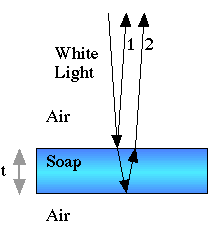 question:
A soap film with index of refraction 1.3 is 450 nm thick. If this
question:
A soap film with index of refraction 1.3 is 450 nm thick. If this  film is illuminated with white light perpendicular to the surface
of the film, what is the color of the reflected light?
film is illuminated with white light perpendicular to the surface
of the film, what is the color of the reflected light? question:
A soap film with index of refraction 1.3 is 450 nm thick. If this
question:
A soap film with index of refraction 1.3 is 450 nm thick. If this  film is illuminated with white light perpendicular to the surface
of the film, what is the color of the reflected light?
film is illuminated with white light perpendicular to the surface
of the film, what is the color of the reflected light?
answer: Remember that for n1 < n2
> n3, t = (m+![]() )
)

The only wavelength above that is visible (between 400 and 700 nm) is
468 nm. Thus the film will appear blue when illuminated with white
light. Note that this wavelength is the wavelength of the light in
air.
Note also that if the film is very thin compared with the wavelength of visible light, no wavelengths will interfere constructively and the film will appear black. You can see this in the middle of a soap film just before it breaks.
question: what would happen if this film were a coating on a glass lens with index of refraction 1.45?
answer: in this case we would have n1 < n2 < n3 and the situation would be destructive interference for 468 nm. The lens would reflect not reflect light with wave lengths in this region.
© MultiMedia Physics 2000